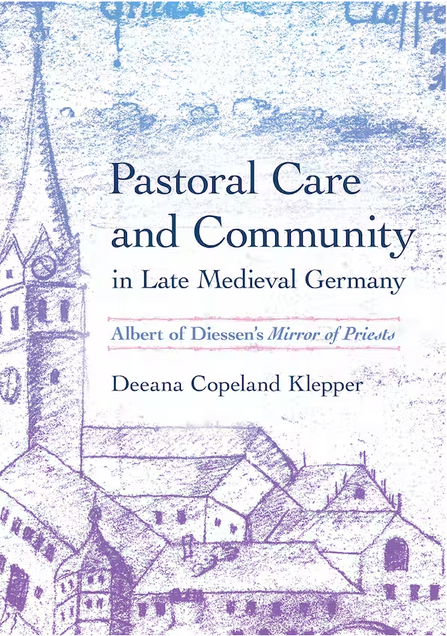Deeana Copeland Klepper: Pastoral Care and Community in Late Medieval Germany: Albert of Diessen’s Mirror of Priests (Cornell University Press, 2022)
Review by Ellie Ash
 Deeana Klepper’s new book, Pastoral Care and Community in Late Medieval Germany, offers a glimpse into the world of fourteenth century Bavaria through the Mirror of the title: a pastoral manual composed by Albert, a canon in the monastery at a small town called Diessen, intended as a “mirror” for parish priests to look into to prepare for their duties. Klepper uses the manual and its manuscripts as another kind of mirror, one that reflects the character of life and religion in the community that produced it. The image in the reflection is sometimes hard to discern, and Klepper is careful about the conclusions she draws. What comes through is an image of a society where Christians in good standing mingled with the religiously marginal: Jews, sinners, sorcerers, and purveyors of superstition.
Deeana Klepper’s new book, Pastoral Care and Community in Late Medieval Germany, offers a glimpse into the world of fourteenth century Bavaria through the Mirror of the title: a pastoral manual composed by Albert, a canon in the monastery at a small town called Diessen, intended as a “mirror” for parish priests to look into to prepare for their duties. Klepper uses the manual and its manuscripts as another kind of mirror, one that reflects the character of life and religion in the community that produced it. The image in the reflection is sometimes hard to discern, and Klepper is careful about the conclusions she draws. What comes through is an image of a society where Christians in good standing mingled with the religiously marginal: Jews, sinners, sorcerers, and purveyors of superstition.
With her analysis of a text meant for a relatively humble, regional audience, Klepper calls for more serious attention to works typically considered minor. Like other parish manuals, the Mirror for Priests is largely made up of selections from larger, more eminent works. But Klepper shows that it would be wrong to conclude that the composition lacks original thought. By examining what he adopted from his models and what he left out, how he adapted his sources and how he revised the text over time, we can see what Albert thought was of practical relevance for the care of souls in Diessen and environs. In this way, parish manuals offer a precious view into how the official teachings of the “universal church” were actually lived out in practice in small local communities.
The topics Albert seems to have found most pressing included improper supernatural practices, relations with Jews, and eschatology. Each reflected social developments of the time, Klepper informs us, and Albert reworked his treatment of them across the three editions of the Mirror that survive in his hand. His attention to the end times and rejection of belief in werewolves and witches reflects the beginnings of growing interest in these topics in central Europe; in both cases, Albert affirms older theological teachings. His attention to Jews may respond to their physical presence within Diessen. The Black Death had prompted a spate of massacres of Jews, and Albert seems to have been anxious to forestall further violence. Killing Jews was one of many sins that prevented one from receiving the Eucharist. Albert’s hands-off approach extended to positive interaction, as well, and he warned that social contact with Jews was sinful.
Unlike modern published books, manuscript manuals like Albert’s were not static texts. Albert himself produced at least three different versions of the Mirror tailored to specific audiences, and his religious brothers continued adding to the copy that remained in Diessen for years. The writing process, Klepper argues, was bidirectional, as reader feedback and annotations shaped versions of the text over time and copyists selected and rearranged material to produce editions suited to the needs of their own communities.
Klepper’s research shows that scribes in small religious houses were not mindlessly reproducing existing books but agentively creating texts that shaped authoritative Christianity for local communities. Pastoral Care and Community in Late Medieval Germany fruitfully brings recent theories in religious studies to bear on conversations about the interplay between conformity and diversity in medieval Christianity.